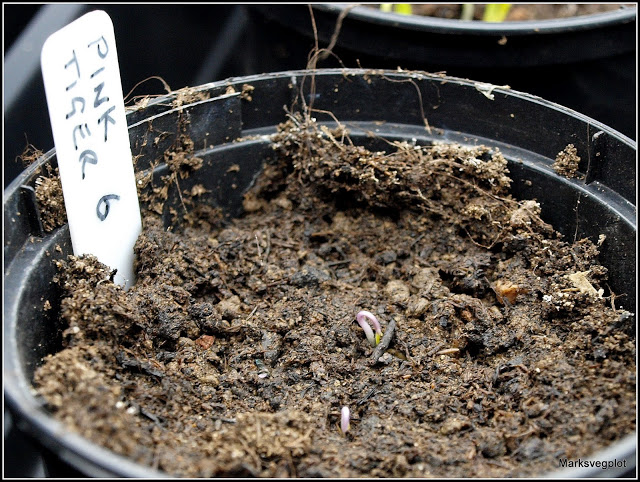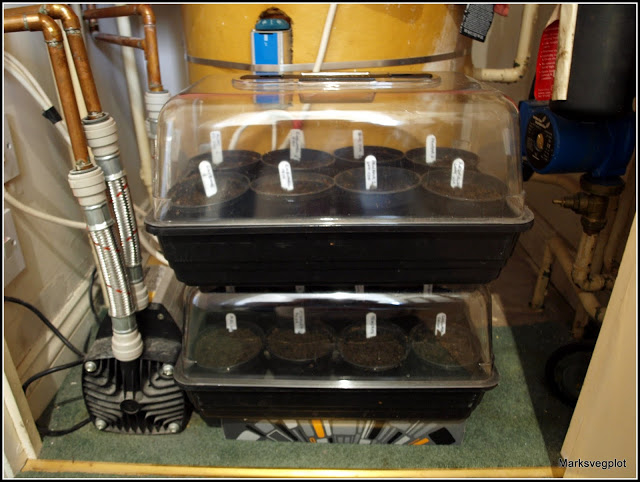

| Online: | |
| Visits: | |
| Stories: |

| Story Views | |
| Now: | |
| Last Hour: | |
| Last 24 Hours: | |
| Total: | |
How to germinate chillis
Latest post from MARKSVEGPLOT – a blog about food and gardening in England”
All over my social media orbit right now I’m seeing people writing about chillis. The early starters already have plants several inches high, and are posting about transplanting them to bigger pots. Others are bemoaning the fact that their seedlings have gone leggy for lack of light – or worse, haven’t germinated at all. My first ones germinated a few days ago. They are a variety called “Fidalgo Roxa”.
 |
| Fidalgo Roxa |
Getting chilli seeds to germinate can be an uncertain business, so I thought I would offer a few hints and tips on this today. I hasten to add that I don’t claim to be an expert on this subject - my words are based on my own experience, which may be different to yours!
The first thing to note is that the chilli is originally a tropical plant (originating in South America or possibly Mexico), so not surprisingly its seeds germinate best in warm temperatures. Our outdoor temperatures here in the UK never get very high, so you will need to give your chillis some help. Possible strategies include:
1. A purpose-built growhouse affair, such as the Vitopod though typically these are pretty expensive (maybe £100 – £150). If money is not a problem for you, this is the most desirable!
2. A more basic electric propagator, which usually costs much less (maybe £25 – £35). Some of these have variable temperature controls and/or thermostats, though of course more features mean higher prices.
3. An unheated propagator – basically a plastic seed-tray with a clear acrylic cover – which you could position on a windowsill above a radiator. You can get one for about £6 – £7.
4. Electric Heat-mats, which are placed underneath a tray of seeds. Prices vary, but if you shop on eBay you can get something suitable for less than £20. If you want one with more features (such as variable temperature), you have to pay a bit more.
5. Put your seeds in the airing-cupboard (if you have one). This is what I do. I use unheated propagators like the ones mentioned at 3 above, which can conveniently be stacked one on top of another.
I keep a thermometer in there too, which indicates that the cupboard reaches temperatures in excess of 30C when the central heating is on, and falls to about 15C overnight. During the day I sometimes prop the door partially open because I don’t want the seeds to get too hot.
6. Keep your seed-tray on top of a fridge. The motor of a fridge puts out quite a bit of heat, so this can be a viable option.
I can’t say with any precision what temperature a chilli seed needs in order to germinate. I think it depends on the type (which is awkward if like me you sow many different types simultaneously). As a general rule I would say that the chillis whose fruits are hottest (e.g. the Capsicum Chinense ones like the Habaneros, Bhuts and Scotch Bonnets) do best in higher temperatures (maybe 25C +), and the milder Capsicum Annuum types will do OK with about 20C. This is of course a big generalisation!
In addition to requiring heat, your chilli seeds will need moisture and a fairly high level of humidity. Many of the options above have built-in covers, but if you want to go for a cheaper option, then putting a simple seed-tray in side a big plastic bag works pretty well. It’s best to clip the bag shut to maintain the humidity at the optimum level.
Another thing that you may not know is that some seeds (including some chillis) germinate better if they are kept in the dark, and some germinate better in the light. If you find your seeds have not germinated after a couple of weeks, try moving them to a different location – light to dark or vice versa.
Some chilli seeds don’t like being buried too deeply, so if you experience poor germination try just laying the seeds on top of the compost rather than burying them. You’ll still need to apply a bit of pressure to ensure that they are in contact with the moist compost.
Once you have sown your seeds, it’s important to keep checking them to see if they have germinated. As soon as they have, you need to move them to a place with lots of light. If you don’t, they will probably go very long and thin (aka “etoliated”). Mine go into the Growlight House – which has good lighting, but no heat source.
Unless you are really lucky, the amount of daylight available on a normal windowsill is seldom sufficient. Before I had the Growlights, I used to laboriously move my seedlings from one side of the house to another twice a day, to give them the best light possible!
 |
| Just germinated – time to go into the Growlight House |
Another question often asked is “How long should I wait before giving up on seeds that have not germinated, and starting again?”. A very tricky question! Some seeds do take a very long time to come up (a month or more). My personal opinion is: leave them 3 weeks, and if nothing has happened, sow another batch – but don’t discard the first batch! I often use a slightly different approach for any second batches – different temperature, different light conditions etc. If you wait too long before re-sowing, you may run out of time. In other words, any plants you do manage to raise will not have enough time to mature and produce fruit before the “good” weather ends.
I hope this post has been of some use to you. If you have any thoughts on the subject, please do contribute them via the Comments box below!
To read more articles like this, on Gardening and Gastronomy, please visit * http://marksvegplot.blogspot.com/ *
Source: http://marksvegplot.blogspot.com/2017/03/how-to-germinate-chillis.html




